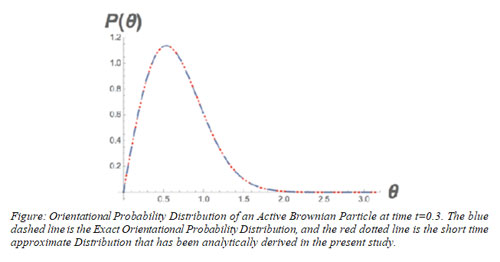 A scientist from Raman Research Institute (RRI), an autonomous institute of the Department of Science & Technology (DST), has analytically calculated and predicted the angular probability distributions of an Active Brownian Particle (ABP), which can help in understanding behaviour of biological systems like bacteria or soft matter systems like driven granular matter, swimming microbes, schools of fish, swarms of birds and so on.
A scientist from Raman Research Institute (RRI), an autonomous institute of the Department of Science & Technology (DST), has analytically calculated and predicted the angular probability distributions of an Active Brownian Particle (ABP), which can help in understanding behaviour of biological systems like bacteria or soft matter systems like driven granular matter, swimming microbes, schools of fish, swarms of birds and so on.ABPs are self-propelled particles which generate dissipative directed motion by consuming energy from the environment. The speed of an ABP is fixed, but its velocity direction is a vector diffusing on the unit sphere. The plots of the angular probability distributions of an ABP derived from the study can be tested against future simulations and real experiments.
The study by Professor Supurna Sinha, which has been accepted for publication in the Journal of Statistical Mechanics: Theory and Experiment, provides analytical forms for the angular probability distribution of an ABP at short, intermediate, and long time scales.
While there has been a fair amount of research in studying the position distribution function of a single active Brownian particle, there are fewer studies addressing the angular probability distribution of an ABP. The researcher has addressed this gap.
Professor Supurna Sinha used methods of non-equilibrium statistical mechanics to compute the angular probability distribution of an ABP. As mentioned earlier, the velocity direction of an ABP is a vector diffusing on the unit sphere. Thus, the study is essentially equivalent to the study of Brownian motion on a sphere. The researcher used approximation techniques to arrive at an elegant expression for the short time angular distribution of an ABP and also got analytical forms which describe the angular distribution of an ABP over all time scales. Thus, the researcher has predictions for the orientational distribution of an ABP over the entire range of time scales, which can be tested against experiments on Active Brownian Particles.
“I have had a long term interest in the area of diffusion and in the study of Brownian motion on a sphere in particular. The present work was triggered by noticing a possible application of diffusion on a sphere in the context of Active Brownian Particles,” mentioned Professor Supurna Sinha.
An Active Brownian Particle and its dynamics can provide a simple model system for understanding biological systems like bacteria or soft matter systems like driven granular matter. In particular, understanding bacterial dynamics is expected to provide insight into diseases stemming from bacterial infections, and driven granular matter has a variety of applications in areas ranging from agriculture to civil engineering to pharmaceutical industry.
Publication details:
`Orientational Probability Distribution of an Active Brownian Particle: an analytical study’ Supurna Sinha To be published in JSTAT (Journal Of Statistical Mechanics: Theory and Experiment)
For further details, Professor Supurna Sinha (supurna[at]rri[dot]res[dot]in) can be contacted.
`Orientational Probability Distribution of an Active Brownian Particle: an analytical study’ Supurna Sinha To be published in JSTAT (Journal Of Statistical Mechanics: Theory and Experiment)
For further details, Professor Supurna Sinha (supurna[at]rri[dot]res[dot]in) can be contacted.






























